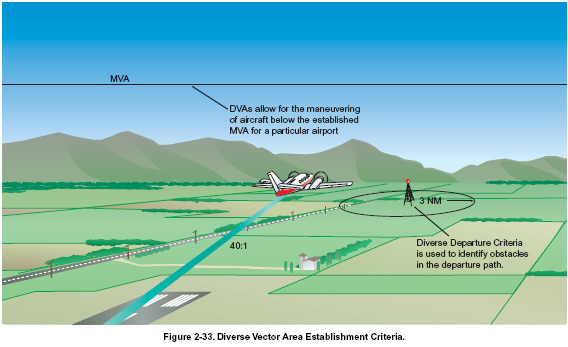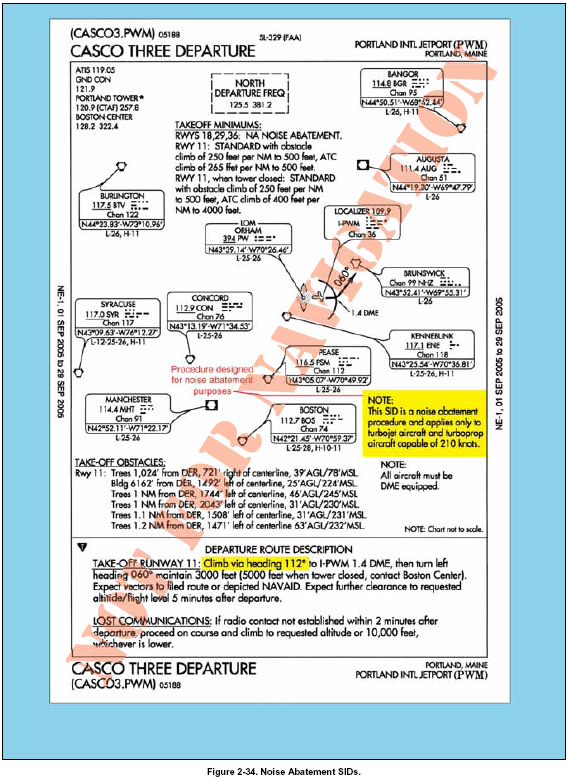 |
|
| INSTRUMENT PROCEDURES HANDBOOK |
|
RADAR DEPARTURE A radar departure is another option for departing an airport on an IFR flight. You might receive a radar departure if the airport does not have an established departure procedure, if you are unable to comply with a departure procedure, or if you request “No SIDs” as a part of your flight plan. Expect ATC to issue an initial departure heading if you are being radar vectored after takeoff, however, do not expect to be given a purpose for the specific vector heading. Rest assured that the controller knows your flight route and will vector you into position. By nature of the departure type, once you are issued your clearance, the responsibility for coordination of your flight rests with ATC, including the tower controller and, after handoff, the departure controller who will remain with you until you are released on course and allowed to “resume own navigation.” For all practical purposes, a radar departure is the easiest type of departure to use. It is also a good alternative to a published departure procedure, particularly when none of the available departure procedures are conducive to your flight route. However, it is advisable to always maintain a detailed awareness of your location as you are being radar vectored by ATC. If for some reason radar contact is lost, you will be asked to provide position reports in order for ATC to monitor your flight progress. Also, ATC may release you to “resume own navigation” after vectoring you off course momentarily for a variety of reasons including weather or traffic. Upon initial contact, state your aircraft or flight number, the altitude you are climbing through, and the altitude to which you are climbing. The controller will verify that your reported altitude matches that emitted by your transponder. If your altitude does not match, or if you do not have Mode C capabilities, you will be continually required to report your position and altitude for ATC. The controller is not required to provide terrain and obstacle clearance just because ATC has radar contact with your aircraft. It remains your responsibility until the controller begins to provide navigational guidance in the form of radar vectors. Once radar vectors are given, you are expected to promptly comply with headings and altitudes as assigned. Question any assigned heading if you believe it to be incorrect or if it would cause a violation of a regulation, then advise ATC immediately and obtain a revised clearance. DIVERSE VECTOR AREA ATC may establish a minimum vectoring altitude (MVA) around certain airports. This altitude is based on terrain and obstruction clearance and provides controllers with minimum altitudes to vector aircraft in and around a particular location. However, it may be necessary to vector aircraft below this altitude to assist in the efficient flow of departing traffic. For this reason, an airport may have established a Diverse Vector Area (DVA). DVA design requirements are outlined in TERPS and allow for the vectoring of aircraft off the departure end of the runway below the MVA. The presence of a DVA is not published for pilots in any form, so the use of a textual ODP in a DVA environment could result in a misunderstanding between pilots and controllers. ATC instructions take precedence over an ODP. Most DVAs exist only at the busiest airports. [Figure 2-33]
VFR DEPARTURE There may be times when you need to fly an IFR flight plan due to the weather you will encounter at a later time (or if you simply wish to fly IFR to remain proficient), but the weather outside is clearly VFR. It may be that you can depart VFR, but you need to get an IFR clearance shortly after departing the airport. A VFR departure can be used as a tool that allows you to get off the ground without having to wait for a time slot in the IFR system, however, departing VFR with the intent of receiving an IFR clearance in the air can also present serious hazards worth considering. A VFR departure dramatically changes the takeoff responsibilities for you and for ATC. Upon receiving clearance for a VFR departure, you are cleared to depart; however, you must maintain separation between yourself and other traffic. You are also responsible for maintaining terrain and obstruction clearance as well as remaining in VFR weather conditions. You cannot fly in IMC without first receiving your IFR clearance. Likewise, a VFR departure relieves ATC of these duties, and basically requires them only to provide you with safety alerts as workload permits. Maintain VFR until you have obtained your IFR clearance and have ATC approval to proceed on course in accordance with your clearance. If you accept this clearance and are below the minimum IFR altitude for operations in the area, you accept responsibility for terrain/ obstruction clearance until you reach that altitude. NOISE ABATEMENT PROCEDURES As the aviation industry continues to grow and air traffic increases, so does the population of people and businesses around airports. As a result, noise abatement procedures have become commonplace at most of the nation’s airports. Part 150 specifies the responsibilities of the FAA to investigate the recommendations of the airport operator in a noise compatibility program and approve or disapprove the noise abatement suggestions. This is a crucial step in ensuring that the airport is not unduly inhibited by noise requirements and that air traffic workload and efficiency are not significantly impacted, all while considering the noise problems addressed by the surrounding community. While most departure procedures are designed for obstacle clearance and workload reduction, there are some SIDs that are developed solely to comply with noise abatement requirements. Portland International Jetport is an example of an airport where a SID was created strictly for noise abatement purposes as noted in the departure procedure. [Figure 2-34 on page 2-36] Typically, noise restrictions are incorporated into the main body of the SID. These types of restrictions require higher departure altitudes, larger climb gradients, reduced airspeeds, and turns to avoid specific areas.
Noise restrictions may also be evident during a radar departure. ATC may require you to turn away from your intended course or vector you around a particular area. While these restrictions may seem burdensome, it is important to remember that it is your duty to comply with written and spoken requests from ATC. Additionally, when required, departure instructions specify the actual heading to be flown after takeoff, as is the case in figure 2-34 under the departure route description, “Climb via heading 112 degrees...” Some existing procedures specify, “Climb runway heading.” Over time, both of these departure instructions will be updated to read, “Climb heading 112 degrees....” Runway Heading is the magnetic direction that corresponds with the runway centerline extended (charted on the AIRPORT DIAGRAM), not the numbers painted on the runway. Pilots cleared to “fly or maintain runway heading” are expected to fly or maintain the published heading that corresponds with the extended centerline of the departure runway (until otherwise instructed by ATC), and are not to apply drift correction; e.g. RWY 11, actual magnetic heading of the runway centerline 112.2 degrees, “fly heading 112 degrees”. In the event of parallel departures this prevents a loss of separation caused by only one aircraft applying a wind drift.
|

